Aranmula is also famous for its traditional metallic mirrors known as Aranmula Kannadi. It is made of copper tin alloy and the ratio is a closely guarded secret.This is a unique art & handed down from generation to generation. Presently only five families are involved in this art in Aranmula and these families hold a patent. We visited one such family and studied the process of manufacture of this unique and beautiful mirror. See pics below:


Saturday, May 15, 2010
Aranmula - A Quaint Kerala Village
12 May 2010: Our next stop was at the Aranmula located at a distance of around 7 Kms from Chengannur. First we visited the Parthasarathy temple, located atop a hill, whose architecture is similar to the Chengannur Temple. It is situated on a sprawling campus with many trees and several sub shrines. We witnessed the Thulabharam (weighing a person on the temple scales against items like rice, bananas, sugar etc which are then given as offerring to the deity) of a 6 months baby and pics are enclosed. 

 Next we visited the Vastu Vidya Gurukulam where we had a morning appointment with the consultant design engineer. Vasthu sasthra is the branch of Veda which deals with traditional Indian way of environmental friendly construction adopting universal principles of creation. This is a combination of science engineering and spirituality. Vastu vidya came from, Sanskrit word Vas & Vidya. Vas means dwell and Vidya is knowledge is stated to spring from Sthapadya Veda the sub Veda of Atharvaveda. Traditional Kerala temple is an excellent example of Vasthu designing. This institution, under Department of Culture, offers consultancy services for Vastu Vidya and Mural painting (Traditional Kerala Temple painting). Enclosing herewith pics of the main office building of the Gurukulam.
Next we visited the Vastu Vidya Gurukulam where we had a morning appointment with the consultant design engineer. Vasthu sasthra is the branch of Veda which deals with traditional Indian way of environmental friendly construction adopting universal principles of creation. This is a combination of science engineering and spirituality. Vastu vidya came from, Sanskrit word Vas & Vidya. Vas means dwell and Vidya is knowledge is stated to spring from Sthapadya Veda the sub Veda of Atharvaveda. Traditional Kerala temple is an excellent example of Vasthu designing. This institution, under Department of Culture, offers consultancy services for Vastu Vidya and Mural painting (Traditional Kerala Temple painting). Enclosing herewith pics of the main office building of the Gurukulam. 
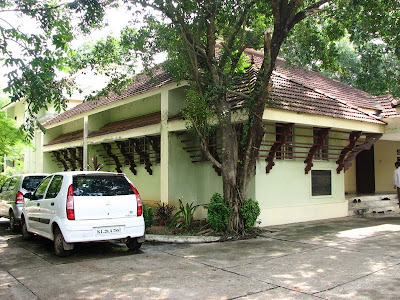 Aranmula is situated on the banks of the river Pamba. We went to the local PWD Guest House, a quaint old building with nice rooms recently renovated. There is a full grown jackfruit tree with plenty of green prickly fruits hanging down. From there we had breathtaking view of the river(see pics below). Incidentally these are nice rooms where one can stay at a very nominal tariff @Rs.500/day :
Aranmula is situated on the banks of the river Pamba. We went to the local PWD Guest House, a quaint old building with nice rooms recently renovated. There is a full grown jackfruit tree with plenty of green prickly fruits hanging down. From there we had breathtaking view of the river(see pics below). Incidentally these are nice rooms where one can stay at a very nominal tariff @Rs.500/day :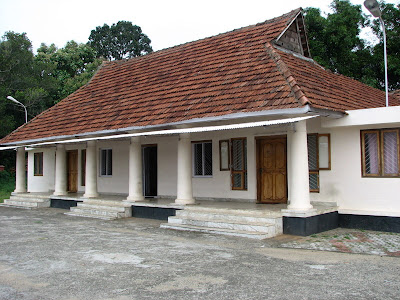

 Vallam Kali means boat race in Malayalam which is the language of the State of Kerala. It is mainly conducted during the season of the harvest festival Onam in Autumn. Vallam Kali include races of many kinds of traditional boats (paddled longboat) of Kerala. The race of Chundan Vallam (snake boat) is the major event. Hence Vallam Kali is also known in English as Snake Boat Race and now in recent years has become a major tourist attraction. Typical snake boats are 100 to 120 feet long, and hold around 100 rowers. Each of the villages in the region has its own snake boat, which they take great pride in. The battling snake boats of Kerala have over 400 years of history associated with them.(Sorry no pics!)
Vallam Kali means boat race in Malayalam which is the language of the State of Kerala. It is mainly conducted during the season of the harvest festival Onam in Autumn. Vallam Kali include races of many kinds of traditional boats (paddled longboat) of Kerala. The race of Chundan Vallam (snake boat) is the major event. Hence Vallam Kali is also known in English as Snake Boat Race and now in recent years has become a major tourist attraction. Typical snake boats are 100 to 120 feet long, and hold around 100 rowers. Each of the villages in the region has its own snake boat, which they take great pride in. The battling snake boats of Kerala have over 400 years of history associated with them.(Sorry no pics!)


Friday, May 14, 2010
Chengannur Mahadeva Kshetram
12 May 2010:
We made a day’s visit to Chengannur & Aranmula , two small but important towns in Kerala State. Our first stop was at Chengannur. It is 117 km north of the state capital Thiruvananthapuram on the banks of the Pamba River. The nearest towns are Pandalam on the south, Thiruvalla on the north, Mavelikkara on the west and Aranmula and Pathanamthitta on the east. It is also the nearest railway station to go to Sabarimalai.(Sabarimalai is the abode of Lord Ayyappa where lakhs of devotees flock every year for darsan after trekking barefoot for miles through jungles and rocky hills)
We made a day’s visit to Chengannur & Aranmula , two small but important towns in Kerala State. Our first stop was at Chengannur. It is 117 km north of the state capital Thiruvananthapuram on the banks of the Pamba River. The nearest towns are Pandalam on the south, Thiruvalla on the north, Mavelikkara on the west and Aranmula and Pathanamthitta on the east. It is also the nearest railway station to go to Sabarimalai.(Sabarimalai is the abode of Lord Ayyappa where lakhs of devotees flock every year for darsan after trekking barefoot for miles through jungles and rocky hills)
Chengannur is famous for its Shiva temple -“Chengannur Mahadeva Kshetram”, where thousands have darshan of Aaratu festival of Goddess Parvati or Devi.(The goddess is taken and immersed in the temple tank in a grand ceremony) As per Temple legends this is assumed to be one of the 51 Shakti Peethas. It is a sprawling temple complex with a circular Sanctum. Lord Shiva and Parvathi Devi are the main investitures of this temple. The vimanam of the main shrine is a conical copper plated structure similar to pagodas in Thailand. Devi’s main Idol is made with an alloy of five metals (Pancha-loham). The temple was constructed centuries back in accordance with an architectural design evolved by the famous Perunthachan.
Here are some photographs of the temple complex:



Here are some photographs of the temple complex:
Thursday, February 4, 2010
Heritage Resort in Kerala
Here are some pics taken during an afternoon visit to Heritage Resort located in Kottayam District of Kerala - set in the backwaters of the Vembanad Lake. The Lake Village Heritage Resort is a lush green planet of shimmering lagoon, meandering canals, herbal gardens & whispering palms. Amongst this stands the traditional Kerala style cottages- alongside the backwaters giving you the feeling of being in a Kerala Houseboat. There is lush green lawn all around. the cottages interspersed with multi coloured varieties of flowers in bloom giving a riot of brightly hued colours in sparkling sunlight - predominant of these are hibiscus and "tecchhi".The Lake Village is an inspirational reproduction of bygone Kerala characterised by backwaters, boating, fishing & traditional fishing nets,wooden houses, garden bathrooms (open to sky). The Village also has facilities like the Mandapam-the culture centre, Ettukettu-the tradional cultural eatout, Nalukettu-the authentic Kerala restaurant, the Koothambalam, the Temple pool,The Banyan Island,the Dhanwantari-Ayurveda Centre. There are a number of fearless resident geese which live in the campus. I could get close enough to some to take some wonderful snaps.The buffet lunch was a veritable feast - a combination of North Indian & Kerala cuisines topped off with ice cream,choco sauce chocolate cake,badam halwa and semiya payasam. After the heavy meal I was tempted to enter one of the wooden cottages, bolt the door from inside and take a nice long nap. Alas that was not to be as I had a meeting set up with the company lawyer immediately thereafter.Here are some resplendent photographs for the connoiseur & nature lover. Good place to plan your next pleasure and leisure vacation !

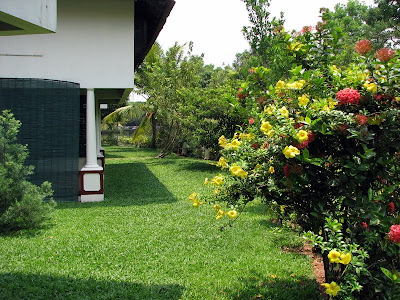




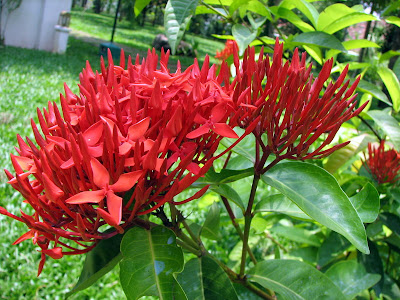





Sunday, January 24, 2010
Historical Sites near Chennai - Sangam Age Temple
THE remains of an ancient brick temple, possibly 2,000 years old, have been discovered on the beach near Tiger Cave in Mamallapuram, 50 km from Chennai. According to archaeologists involved in the excavation, the temple; dedicated to Muruga, also known as Karthikeya, may date back to the late Tamil Sangam age, between 1st century B.C. and 2nd century A.D. An inscription in Tamil on a rock near the excavated site led to the discovery of the temple. The rock, lodged in sand, was exposed fully by the tsunami that struck Mammalapuram on December 26, 2004.
The original temple was damaged severely by what archaeologists think was a tsunami or a massive tidal wave action. Subsequently, the Pallava kings converted it into a granite temple in the 8th and 9th century A.D., which too fell to tidal waves . The Pallava rulers filled the sanctum sanctorum of the brick temple with sand, placed granite slabs over it and used it as a foundation to build a new temple. This temple had a vimana (tower) made of granite blocks with carvings. So the temple had two distinct phases: the late Sangam age and the Pallava period. 
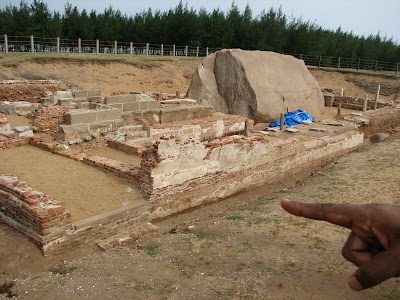
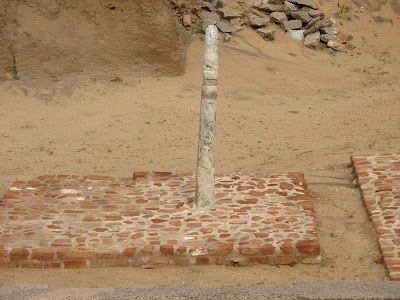










An important discovery was that of two carved, granite pillars of the Pallava period. Both the pillars have inscriptions in Tamil. While one pillar mentions the seventh regnal year (813 A.D.) of the Pallava king Dantivarman, the other has an inscription belonging to the 12th regnal year (858 A.D.) of another Pallava king, Nandivarman III. The inscriptions on the pillars speak about donations made to a Subrahmanya temple at a place called Thiruvizhchil, which is the present-day Salavankuppam, where the Tiger Cave monuments are located.
Other Pallava age artefacts unearthed include carved granite blocks from the collapsed temple vimana, a bronze lamp with a carving of a cock (the vehicle of Muruga or Subrahmanya), and roofing tiles. The granite blocks have carvings of Ganesa, elephants, mythical animals and floral motifs. A copper coin belonging to the Chola period was found on the surface of the site. 
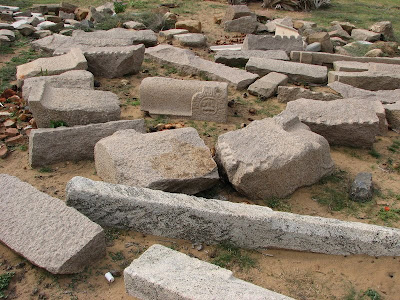


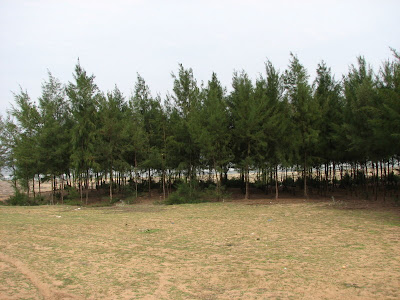



Other Pallava age artefacts unearthed include carved granite blocks from the collapsed temple vimana, a bronze lamp with a carving of a cock (the vehicle of Muruga or Subrahmanya), and roofing tiles. The granite blocks have carvings of Ganesa, elephants, mythical animals and floral motifs. A copper coin belonging to the Chola period was found on the surface of the site.
Thursday, January 14, 2010
Historical Sites Near Chennai - Mamalla Quarries
Mahabalipuram was under control by Pallava kings from the Third Century to Ninth century AD. Mahabalipuram , a world heritage site, famous centre of Pallava art and architecture in South India, was also a seaport right from the beginning of the Christian era. The epigraphical sources confirm Pallava kings' active contacts with Ceylon, China and the Southeast Asian countries. A few Roman coins of Theodosius (4th century AD) found from the region suggest that Mababalipuram also had trade contact with the Roman world around Christian era. It came to the glory only after the Pallava started building the structural and monolithic temple architecture in this area.
Shown below are pictures taken during recent visit to the Valiankuttan and Pidari Rathams at Mamalla Quarry at Mahabalipuram.
Pictures
1 & 2: Bas Relief of Hindu elephant god Ganesha.
3 & 4: Unfinished Valiankuttan rathas (chariots) carved from monolithic granite blocks
5,6 & 7 : Quarried blocks of granite - unsuitable because of cracks & fissures
8 & 9: Shows how the rocks are dressed
10-15: Unfinished Pidari rathas - not completed because of defects in rock
16: View of Light House Mahabalipuram from Quarry
Shown below are pictures taken during recent visit to the Valiankuttan and Pidari Rathams at Mamalla Quarry at Mahabalipuram.
Pictures
1 & 2: Bas Relief of Hindu elephant god Ganesha.
3 & 4: Unfinished Valiankuttan rathas (chariots) carved from monolithic granite blocks
5,6 & 7 : Quarried blocks of granite - unsuitable because of cracks & fissures
8 & 9: Shows how the rocks are dressed
10-15: Unfinished Pidari rathas - not completed because of defects in rock
16: View of Light House Mahabalipuram from Quarry
Subscribe to:
Posts (Atom)
RAMAL RAMANATHAN'S 95th BIRTHDAY
Wedding Studio Photo Appa's 90th Birthday Ayushhomam at Coimbatore: 2006 Wedding Photo Photos clicked on Birthday at Coimbatore Special ...

-
Thenilapuram is a small village in Palakkad district of Kerala around 80 Kms south of Coimbatore where I live. We travelled to this village ...
-
Upanayanam, also known as the sacred thread ceremony. is usually performed for Brahmin boys at the age of seven or eight because that is th...
